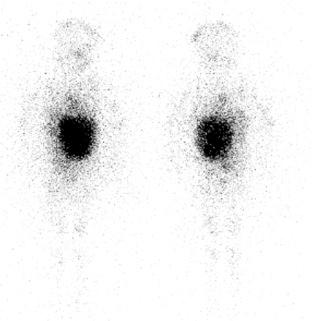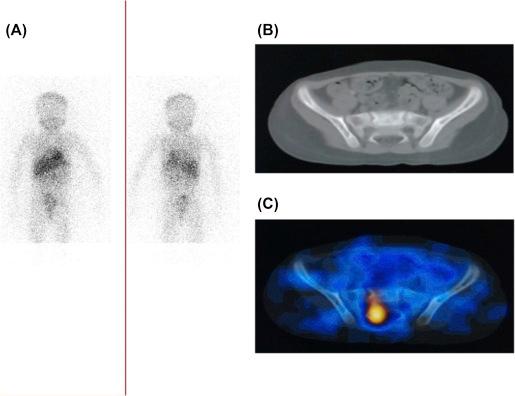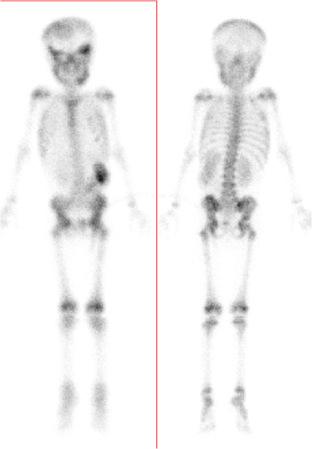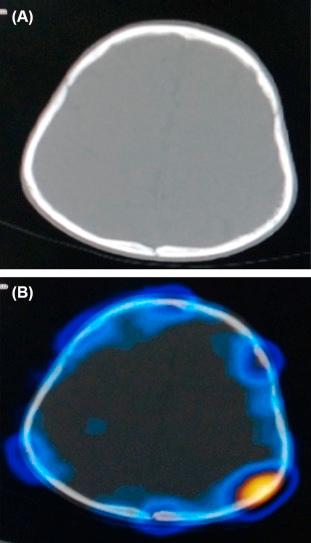Physical Address
304 North Cardinal St.
Dorchester Center, MA 02124
No funding received from any organization for this study.
The authors declare that there is no conflict of interest.
Neuroblastoma tumors are usually detected in a symptomatic child. Sometimes, it may be noticed incidentally. If child is symptomatic and presents with an abdominal mass, the first investigation should be ultrasonography (USG). The tumor is heterogeneous, and most of the time USG will show calcification in it. Adrenal masses displace the kidney inferiorly. It may encase surrounding vessels also, and it may be well appreciated on USG. USG may show metastatic lesions in liver also.
If neuroblastoma is highly suspected, the next investigation of choice is a magnetic resonance (MR) or computed tomography (CT). MR is helpful in diagnosing local and intraspinal invasion of the tumor, and also bone marrow metastasis. However, CT is convenient and rapid, which becomes important in the case of the pediatric population. The tumor appears as a large lobulated solid mass displacing the neighboring organs.
Other abdominal solid tumors with similar location must be differentiated with neuroblastoma. Wilms' tumor that arises in the kidney is the most important differential diagnosis. It infiltrates the vessels and produces tumor thrombus in the renal vein, and may sometimes extend to the inferior vena cava (IVC). However, neuroblastoma arises in the adrenals, mostly shows calcification, pushes the kidney inferiorly, and encases the vessels. Adrenocortical carcinoma, a rare tumor, also presents as a conglomerated solid mass and so produces similar imaging features on CT/MR. However, unlike neuroblastoma, it often secretes steroids, leads to Cushing syndrome, virilization, and so on .
Sites other than abdominal are cervical, cervico-thoracic, mediastinal, and retroperitoneal other than adrenal. They arise along the sympathetic chain, and most of them show calcification with or without intraspinal extension. Despite intensive multimodality approach to therapy in cases of neuroblastoma, approximately, only 30%–40% long-term survival rates could be achieved in its high-risk group .
However, low-risk and intermediate-risk groups have survival rates of more than 90% with surgery and with or without chemotherapy. Factors affecting the risk groups are the stage of disease, patients age, and other biological factors (like histopathology, DNA index, and MYCN amplification) .
Being an analog of catecholamine precursor, MIBG utilizes type I catecholamine reuptake method for transportation into the tumor cells. After administration, it gets concentrated into the tumor cytoplasm. However, its retention depends upon fast reuptake of any MIBG leaving the tumor cells. It gets concentrated in the primary tumor as well as in metastatic sites like bone, bone marrow, and lymph nodes in 90%–95% of the patients .
One out of 10 cases among the diagnosed cases of neuroblastoma may show MIBG negativity during initial evaluation or therapy. However, no obvious association could be established in MIBG negative scintigraphy and prognosis of neuroblastoma . Initially, MIBG labeled with iodine 131 ( 131 I) was used for neuroblastoma imaging .
Physiological MIBG uptake by thyroid should be blocked by the administration of Lugol's iodine 1% (saturated solution of potassium iodide). It should be administered as 1 drop/kg to max 40 (20 drops, twice daily). The thyroid block should be started a day before radiotracer injection and should be continued 1–2 days for 123 I-MIBG and 3–6 days for 131 I-MIBG. However, a single dose before MIBG administration has also been shown to sufficiently block thyroid uptake of the radiotracer. In comparison to 131 I-MIBG, 123 I-MIBG has low risk to thyroid gland .
The administered doses of 131 I-MIBG are restricted by long physical half-life (8 days) of 131 I-MIBG, high-energy photon (364 keV), and emission of the beta particle, which has no use for a diagnostic purpose. In comparison, 123 I-MIBG has a shorter physical half-life (13 h), ideal photon energy for gamma camera (159 keV), and without any beta particle emission. Its finer image quality and lower radiation dose soon made it the preferred imaging modality. In 2008, the Food and Drug Administration (FDA) approved 123 I-MIBG for its clinical use in children. However, it is not yet widely available . The North American Consensus Guidelines recommend the administered 123 I-MIBG doses of 0.14 mCi/kg (5.2 MBq/kg) with a minimum dose of 1 mCi (37 MBq) and a maximum dose of 10 mCi (370 MBq) .
Planar and single photon emission computed tomography (SPECT) and/or SPECT/CT images are usually done 24 h after 123 I-MIBG injection to provide better localization and high target to background ratio. Supplementary planar imaging can be performed at 48 h, if desired, to shed light on abnormal focal uptake ( Fig. 8.1 ). The delayed imaging technique is also of help in differentiation between true positive lesions and bowel tracer activity, as it gets cleared later with time.

MIBG is excreted via urine with physiological tracer activity seen in the kidneys and bladder. Normal adrenal glands can also exhibit MIBG activity. Salivary glands, nasal mucosa, myocardium, liver, and bowel can also demonstrate physiological MIBG uptake. There is always the probability of missing the lesion in close proximity to these areas . After unilateral adrenalectomy, the other normal adrenal gland may show increased MIBG uptake. Also, children with brown adipose tissue can show MIBG uptake in the neck and supraclavicular regions .
In the diagnosis of neuroblastoma, MIBG has a sensitivity and specificity of 88%–93% and 83%–92%, respectively. Sometimes, a misreading of physiological focal uptake can lead to false-positive MIBG results. MIBG uptake in mature ganglioneuromas and other neuroendocrine tumors can mislead to false positive results. Post-therapy patients with a microscopic disease can give false negative results .
Medications, which are known to interfere with MIBG uptake should be stopped well before the test. Anti-hypertensive and other cardiac agents (e.g., bretylium, guanethidine, reserpine, calcium channel blockers), antipsychotics (e.g., butyrophenones, loxapine, phenothiazines), opioids, sympathomimetics, and tricyclic antidepressants should be stopped 1–3 weeks before the investigation. On the one hand, planar images are helpful in the whole-body evaluation, as neuroblastoma is known for widespread metastatic disease; on the other hand, SPECT imaging, particularly of the abdomen, is needed for the lesion's anatomic localization .
MIBG can detect distant marrow lesions, which are missed during bone marrow biopsy or other imaging modalities. It can upstage the disease, and so, the planning of therapy and prognosis . Also, MIBG scans help in confirmation of lesions found suspicious in other imaging modalities . MIBG positive but chemo-resistant lesions can also be targeted for MIBG therapy, or can be considered for radiotherapy.
Fusion of SPECT with CT is helpful in the anatomic correlation of the lesion with tissue involved by the disease. It also decreases the frequency of false positive interpretations. In many cases of retroperitoneal MIBG tracer activity, MIBG with SPECT/CT helps in the differentiation of physiological uptake with true positive lesions. No doubt, SPECT fused with CT improves the specificity of the modality ( Fig. 8.2 ) . In cases of neuroblastoma, in children with age of more than 1 year, and also with metastatic disease, MIBG scans at diagnosis may evaluate the disease prognosis. It can also predict the response to chemotherapy . There is a high probability of disease relapse if MIBG scans are positive after induction chemotherapy .

Follow-up MIBG scans are helpful in diagnosing disease relapse and disease progression by detecting bony metastases and other lesions with high sensitivity, especially, patients in the high-risk category . Semiquantitative scoring systems have been described for MIBG imaging of neuroblastoma to increase interobserver agreement and also to improve the precision of reporting. It has been noted that MIBG scores can correlate very well with the overall treatment response and event-free survival .
The conventional 99 mTc-methylene diphosphonate (MDP) bone scan is used to evaluate cortical bone metastases in neuroblastoma. Bone with active metabolism promptly takes MDP. MDP accumulation is also noted in the primary tumor ( Fig. 8.3 ). However, no prognostic relation could be established with this phenomenon. Initial studies suggested that MIBG underestimates the number and extent of bone metastases in comparison to bone scans. Also, MDP scintigraphy proved to be better in comparison to skeletal survey with plain X-ray in metastatic site evaluation . In addition, SPECT/CT can be performed for further confirmation of suspected skeletal metastatic site ( Fig. 8.4 ). However, later MIBG showed its superiority and revealed more bony lesions in comparison to MDP .


Bone scans can differentiate cortical bone from marrow metastases. This delineation is important in the staging of the patient of less than 18 months of age. However, physiologically increased demand in growth plates of children makes metastatic evaluation difficult and can lead to false positive or negative result in bone scintigraphy. Bone scans may be positive after trauma, in the absence of tumor involvement. Persistence of uptake after eradication of tumor involvement can also lead to false-positive bone scans . A bone scan is still typically performed at diagnosis for disease staging.
Become a Clinical Tree membership for Full access and enjoy Unlimited articles
If you are a member. Log in here